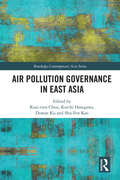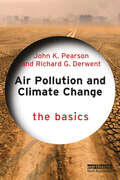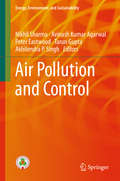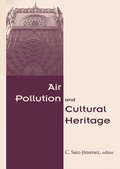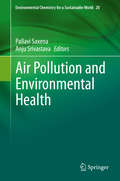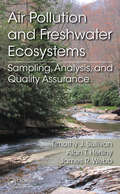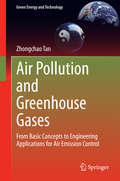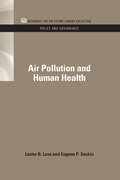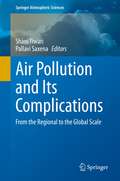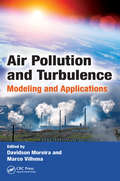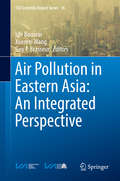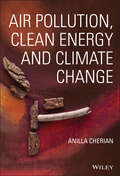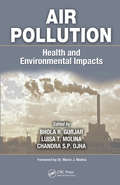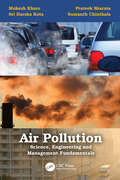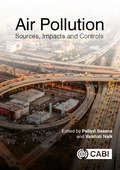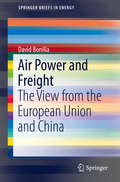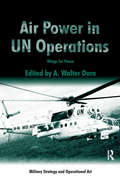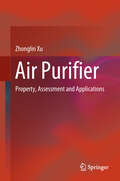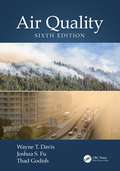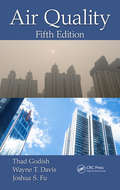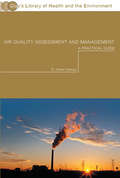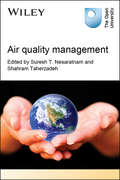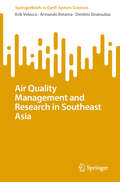- Table View
- List View
Air Pollution Governance in East Asia (Routledge Contemporary Asia Series)
by Kuei-Tien Chou Koichi Hasegawa Dowan Ku Shu-Fen KaoFocussing on Taiwan, South Korea, Japan and Mainland China, the contributors to this book analyse various cases of air pollution within East Asia. Air pollution in East Asia is a major health risk, which also has damaging impacts on the environment leading to impacts on society, economic growth and welfare. While existing laws and policies have made progress in alleviating air pollution in each country in the region, the protection of favourable environments and he resolution of transboundary air pollution problems have become major targets of regional cooperation. Combining perspectives from social sciences and science, technology, society studies, the contributors to this book examine both the technical and socio-economic-political aspects of these challenges, through a range of case studies from around the region. A valuable read for researchers and policy-makers looking at air pollution and transboundary governance challenges within and beyond East Asia.
Air Pollution and Climate Change: The Basics (The Basics)
by John K. Pearson Richard DerwentThis book identifies four key forms of air pollution: indoor, urban, regional and global. It discusses how these four types of pollution are manifest in today’s society and examines the scientific and policy challenges that stand in the way of progress. Written in a style that balances scientific underpinnings with accessible language, Pearson and Derwent examine the sources and historical context of air pollutants, before dedicating a chapter to each of the key forms. Armed with these basics, they begin to address the challenges faced by improving indoor, urban and regional air quality, whilst reducing global warming in the years ahead. This leads to a greater understanding of the challenges of global climate change, with new proposals for reducing global warming. However, the authors conclude that it is only when we have a scenario of reforestation combined with reductions in emissions of all greenhouse gases that real progress will be made in the fight against climate change. Then, air pollution will also be consigned to history. With a foreword written by Professor James Lovelock, this book will be of great interest to students and scholars of climate change and environmental policy, as well as air quality professionals working in this important field.
Air Pollution and Control (Energy, Environment, and Sustainability)
by Avinash Kumar Agarwal Tarun Gupta Akhilendra P Singh Nikhil Sharma Peter EastwoodThis book focuses on various aspects related to air pollution, including major sources of air pollution, measurement techniques, modeling studies and solution approaches to control. The book also presents case studies on measuring air pollution in major urban areas, such as Delhi, India. The book examines vehicles as a source of air pollution and addresses the quantitative analysis of engine exhaust emissions. Subsequent chapters discuss particulate matter from engines and coal-fired power plants as a major pollutant, as well as emission control techniques using various after treatment systems. The book's final chapter considers future perspectives and a way forward for sustainable development. It also discusses several emission control techniques that will gain relevance in the future, when stricter emission norms will be enforced for international combustion (IC) engines as well as power plants. Given its breadth of coverage, the book will benefit a wide variety of readers, including researchers, professionals, and policymakers.
Air Pollution and Cultural Heritage
by C. Saiz-JimenezThis collection includes thirty-six important recent works on the effects of pollutants on heritage sites, including thirty papers delivered to the Seville International Workshop on Air Pollution and Cultural Heritage in 2003, and six invited new additions. All papers have been written by a team of leading international contributors and are divided into five subject areas to cover the main topics of interest today. This volume is aimed at archaeologists and molecular biologists as well as advanced students and researchers in the fields of biodeterioration, building materials, micro-organisms and cultural heritage.
Air Pollution and Environmental Health (Environmental Chemistry for a Sustainable World #20)
by Pallavi Saxena Anju SrivastavaAir pollution is an alarming problem, not only in terms of air quality, but also in relation to health issues. Toxic air pollutant concentrations produce harmful impacts on plant health and human health. Further, though there are various sources of air pollution, anthropogenic and biogenic sources are becoming increasingly problematic. A number of control methods have been applied to reduce the air pollutant concentrations so that their global environmental burden on plants as well as humans can be mitigated. However, as confirmed in numerous reports and studies, their concentrations continue to be very high and everyday cases related to air pollution have become exponentially high not only in developing countries but also in developed countries. In plants, toxic air quality has various adverse effects, including biochemical and physiological disorders, chronic diseases and/or lower yields. In humans, air pollutants affect the body’s metabolism and immune system, lungs and central nervous system. This book provides an essential overview of air pollution, its impacts on plant and human health, and potential control strategies. The respective chapters cover general monitoring and characterization techniques for air pollutants, air quality modelling applications, plant and human health effects, risk assessment, and air pollution control policy. Given its scope, the book offers a valuable and unique resource for students of Environmental Science, Biological Science, Medical Science and Agriculture; and for environmental consultants, researchers and other professionals whose work involves air quality, plant and human related research.
Air Pollution and Freshwater Ecosystems: Sampling, Analysis, and Quality Assurance
by Timothy J Sullivan Alan T. Herlihy James R. WebbA practical book for professionals who rely on water quality data for decision making, this book is based on three decades experience of three highly published water and watershed resource professionals. It focuses on the analysis of air pollution sensitive waters and the consequent effects associated with soil and water acidification, nutrient-
Air Pollution and Greenhouse Gases: From Basic Concepts to Engineering Applications for Air Emission Control (Green Energy and Technology)
by Zhongchao TanThis textbook discusses engineering principles relating to air pollution and greenhouse gases (GHGs); it focuses on engineering principles and designs of related devices and equipment for air emission control for a variety of industries such as energy, chemical, and transportation industries. The book aims primarily at senior undergraduate and graduate students in mechanical, chemical and/or environmental engineering departments; it can also be used as a reference book by technical staff and design engineers who are interested in and need to have technical knowledge in air pollution and GHGs. The book is motivated by recent rapid advances in air pollution and greenhouse gas emissions and their control technologies. In addition to classic topics related to air pollution, this book is also featured with emerging topics related to air pollution and GHGs. It covers recent advances in engineering approaches to the reduction of GHG emissions including, but are not limited to, green energy technologies and carbon sequestration and storage. It also introduces an emerging topic in air pollution, which is referred to as Nano Air Pollution. It is a growing concern in air pollution, but largely missing in similar books, likely because of recent rapid advances in nanotechnology has outpaced the advances in nano air pollution control.
Air Pollution and Human Health (RFF Policy and Governance Set)
by Lester B. Lave Eugene P. SeskinUpon competition of a ten year research project which analyzes the effect of air pollution and death rates in US cities, Lester B. Lave and Eugene P. Seskin conclude that the mortality rate in the US could shrink by seven percent with a similar if not greater decline in disease incidence if industries followed EPA regulations in cutting back on certain pollutant emissions. The authors claim that this reduction is sufficient to add one year to average life expectancy. Originally published in 1977.
Air Pollution and Its Complications: From the Regional to the Global Scale (Springer Atmospheric Sciences)
by Pallavi Saxena Shani TiwariThis book provides an overview of the fundamental concept of air pollution, emission sources of air pollutants and their transportation.First, the book presents a brief background on air pollution and its emission sources, then it continues with their impact on agriculture, health, and climate change. Furthermore, it covers the basic concepts of air pollution, transportation of air pollutants, global climate change and the use of science in air pollution policy formulation in detail. It also emphasizes the effects of air pollutants in altering the onset pattern of the Indian Summer Monsoon. In addition, it describes the impacts of air pollution on the cryosphere and human health.In this book the editors provide an interdisciplinary unique collection of new studies and findings on the groove of air pollution, to improve the basic understanding of graduate students as well as researchers in the field of air pollution and its impacts on various aspects of the atmosphere and surroundings. This collection covers the basic concepts of air pollution, transportation of air pollutants, and global climate change and the use of science in air pollution policy formulation.
Air Pollution and Turbulence: Modeling and Applications
by Davidson Moreira Marco VilhenaSince its discovery in early 1900, turbulence has been an interesting and complex area of study. Written by international experts, Air Pollution and Turbulence: Modeling and Applications presents advanced techniques for modeling turbulence, with a special focus on air pollution applications, including pollutant dispersion and inverse problems. The
Air Pollution in Eastern Asia: An Integrated Perspective (ISSI Scientific Report Series #16)
by Xuemei Wang Idir Bouarar Guy P. BrasseurThis book, written by an international group of experts from China, Europe and the USA, presents a broad and comprehensive analysis of the chemical and meteorological processes responsible for the formation of air pollutants in eastern Asia, and in particular for the development of severe pollution episodes observed primarily during winter in the northeastern part of China. With the rapid population growth, economic development and urbanization occurring in Asia, air pollution has become a major environmental problem in this part of the world. The book is organized around six distinct parts. The first part of the volume offers a general perspective on issues related to air pollution including persistent haze events in eastern and southern Asia. The second part presents an overview of air pollution sources (i. e. , anthropogenic and biomass burning sources). The third part analyzes in-situ observations of chemical species in China, while the fourth part focuses on space observations of gas-phase and aerosol species. The modeling aspects are treated in the fifth part of the volume, which includes a presentation of several air quality forecast systems and an assessment of the role of urbanization on air pollution levels. Finally, the effects of air pollution on health and crop productivity in China are discussed in the last part of the book. The book also presents an integrated view of past and present situations in Asia and provides the scientific basis from which mitigation policies can be established and air quality can be improved. Audience: This book is written for scientists, educators, students, environmental managers, policy-makers and leaders in public administration and private corporations who wish to use science-based information to mitigate air pollution. The book should help decision-makers to design effective policies for air quality improvement and to successfully manage short-term air pollution episodes that substantially affect people's quality of life and strongly impact the economy.
Air Pollution, Clean Energy and Climate Change
by Anilla CherianAIR POLLUTION, CLEAN ENERGY AND CLIMATE CHANGE Anthropogenic climate change is a globally recognized threat multiplier. Yet, decades of intergovernmental negotiations have failed to curb toxic levels of fossil fuel energy-related air pollution which the World Health Organization (WHO) has identified as the world's largest, single environmental health risk. Lying in plain view are the troubling truths about the morbidity and ill-health burdens associated with anthropogenic climate change that are borne by those who have done the least to contribute to per capita emissions of greenhouse gas emissions. Ignoring the nexus between air pollution, lack of access to clean energy and climate adversities represents a collective failure of the UN's ambitious, universally agreed upon 2030 Sustainable Development Agenda (SDA) which pledged 'to leave no one behind'. This book highlights the air pollution crisis that emanates from the heavy reliance on polluting forms of energy and the urbanization of poverty in developing countries. It provides a framework for understanding why the broader sustainable development community needs to address the more neglected intersection between adverse climatic impacts and energy-related air pollution which devastates the lives of the poorest and most vulnerable amongst us, especially young children, women and the elderly. It focuses on the importance of breaking down persistent global silos and goals on sustainable energy for all, and climate change reflected in the UN's 2030 SDA, and the 2015 Paris Agreement. Integrating clean air and climate mitigation measures that specifically include curbing short lived climate pollutants such as black carbon via innovative partnerships/modalities are seen as vital to clean energy and climate responsive action. This book argues that linked actions by non-nation state actors aimed at reducing air pollution and ameliorating short term climate pollutants in the most populous cities, particularly in countries like India where annual average particulate matter pollution levels consistently exceed WHO guidelines are essential in reducing grave health costs and disease burdens. Air Pollution, Clean Energy and Climate Change will be of particular interest to policy makers, researchers, environmental advocates, civil society stakeholders and practitioners who want to understand the urgency of addressing linkages between climate change, fossil fuel energy, air pollution and public health risks. The cover image is an oil painting by Anilla Cherian, which incorporates tree bark and twigs, and serves as a reminder of the daily energy sources used by millions who lack access to clean energy and are exposed to high levels of household air pollution. It is the second-part of a series, with the first one serving as the cover image to Energy and Global Climate Change (Cherian, 2015). Photograph of painting by Alison Sheehy Photography.
Air Pollution: Health and Environmental Impacts
by Luisa T. Molina Bhola R. Gurjar Chandra S. P. OjhaAir pollution is recognized as one of the leading contributors to the global environmental burden of disease, even in countries with relatively low concentrations of air pollution. Air Pollution: Health and Environmental Impacts examines the effect of this complex problem on human health and the environment in different settings around the world. I
Air Pollution: Science, Engineering and Management Fundamentals
by Prateek Sharma Mukesh Khare Sumanth Chinthala Sri Harsha KotaThis comprehensive and up-to-date textbook discusses fundamental aspects of air pollution with the help of solved and case examples within the chapter and review questions at the end of each chapter. The textbook discusses in depth the entire domain of air pollution, from the fundamentals, sources, types, effects, associated risks, ecology, meteorology, climatology, sampling, monitoring and instrumentation, laboratory quality control, data analysis and interpretation, modelling, control technologies and indoor air pollution, to the latest principles of air quality management and legislation, regulations and standards.This book: Covers fundamentals of air pollution, the atmosphere, air pollution meteorology, effects and control of air pollution Discusses engineering aspects of air quality management and includes concepts of ecology, growth, and sustainable development in the context of air pollution Explains air pollution mitigation philosophies, legislation, regulations, and standards Comprehensively discusses topics including air quality monitoring, sampling, air quality modelling and air quality data analysis Includes case examples for better understanding of the topics and solution manual for the benefit of instructors The text will be useful for senior undergraduate and post-graduate students in the fields of science and engineering. Pedagogical features including solution manual will be uploaded on the website.
Air Pollution: Sources, Impacts and Controls
by Amit Kumar Pallavi Saxena Professor Vaishali Naik Amit Awasthi Sangeeta Bansal Monojit Chakraborty Naveen Chandra Arti Choudhary Manisha Gaur Vineet Goswami Tarun Kumar Gupta Harpreet Kaur Priyanka Kulshrestha Ruchi Kumari Chinmay Mallick Renu Masiwal Vandana Maurya Neha Mishra Prashant Rajput Anuradha Shukla Gyanesh Kumar Singh Ravi Prakash Singh Ruchi Singh Saumya Singh Saurabh Sonwani Shani TiwariAir pollution has become a major global issue due to rapid industrialization, human population growth and increasing urbanization. The various sources of atmospheric pollutants, both those created by human activity and those from natural physical and biological processes, have become the focus of much scientific research and analysis. An understanding of how these many pollutants are affecting air quality is essential in order to design strategies to mitigate them. Written by a team of international experts, this book aims to provide a broad overview of the issues surrounding air pollution and how to control and monitor pollution levels. Beginning with a brief background on the subject, the book moves on to discuss global emissions, with an emphasis on megacities and their effects. Possible pollution control measures and methods of air pollution measurement and modelling are also explored. The book ends with descriptions of the various indices used for assessing air quality with a focus on human health impacts, and a discussion on policy making to control air pollution. The book will be useful to students of environmental science and atmospheric science, as well as environmental consultants and researchers interested in air quality . Key Features: Comprehensive introduction to the primary causes of air pollution today with an emphasis on growing urban populations and megacities Discusses both anthropogenic and biogenic emissions and their effects on human health and the environment Gives an overview of indices used today for assessing air quality and describes current methods for air pollution monitoring and modelling Discusses new technologies for mitigating the effects of air pollution and policy making for implementation of controls
Air Pollution: Sources, Impacts and Controls
by Amit Kumar Professor Vaishali Naik Amit Awasthi Sangeeta Bansal Monojit Chakraborty Naveen Chandra Arti Choudhary Manisha Gaur Vineet Goswami Tarun Kumar Gupta Harpreet Kaur Priyanka Kulshrestha Ruchi Kumari Chinmay Mallick Renu Masiwal Vandana Maurya Neha Mishra Prashant Rajput Anuradha Shukla Gyanesh Kumar Singh Ravi Prakash Singh Ruchi Singh Saumya Singh Saurabh Sonwani Shani TiwariAir pollution has become a major global issue due to rapid industrialization, human population growth and increasing urbanization. The various sources of atmospheric pollutants, both those created by human activity and those from natural physical and biological processes, have become the focus of much scientific research and analysis. An understanding of how these many pollutants are affecting air quality is essential in order to design strategies to mitigate them. Written by a team of international experts, this book aims to provide a broad overview of the issues surrounding air pollution and how to control and monitor pollution levels. Beginning with a brief background on the subject, the book moves on to discuss global emissions, with an emphasis on megacities and their effects. Possible pollution control measures and methods of air pollution measurement and modelling are also explored. The book ends with descriptions of the various indices used for assessing air quality with a focus on human health impacts, and a discussion on policy making to control air pollution. The book will be useful to students of environmental science and atmospheric science, as well as environmental consultants and researchers interested in air quality . Key Features: Comprehensive introduction to the primary causes of air pollution today with an emphasis on growing urban populations and megacities Discusses both anthropogenic and biogenic emissions and their effects on human health and the environment Gives an overview of indices used today for assessing air quality and describes current methods for air pollution monitoring and modelling Discusses new technologies for mitigating the effects of air pollution and policy making for implementation of controls
Air Power and Freight: The View from the European Union and China (SpringerBriefs in Energy)
by David BonillaThis book addresses the challenges of planning sustainable freight transport systems (road and air) in a time when the industry faces increasing pressure from environmental limits, climate change, carbon emission targets, bottlenecks in oil supply, infrastructure shortages and urban congestion. The author examines sustainable freight transport over the last 45 years on three continents, and includes developments on transport economics, logistics and transport geography as well as environmental economics. Readers will gain valuable insight on a number of practices and methodologies that will assist in making their systems more sustainable with fewer negative environmental effects at both the local and global level.
Air Power in UN Operations: Wings for Peace (Military Strategy and Operational Art)
by A. Walter DornAir power for warfighting is a story that's been told many times. Air power for peacekeeping and UN enforcement is a story that desperately needs to be told. For the first-time, this volume covers the fascinating range of aerial peace functions. In rich detail it describes: aircraft transporting vital supplies to UN peacekeepers and massive amounts of humanitarian aid to war-affected populations; aircraft serving as the 'eyes in sky' to keep watch for the world organization; and combat aircraft enforcing the peace. Rich poignant case studies illuminate the past and present use of UN air power, pointing the way for the future. This book impressively fills the large gap in the current literature on peace operations, on the United Nations and on air power generally.
Air Purifier: Property, Assessment and Applications
by Zhonglin XuThis book discusses the development, types and application principles of portable air purifiers in China. It analyzes the theoretical characteristics of air purifiers under various operational conditions, and points out that the term “Clean Air Delivery Rate” cannot be used to precisely reflect the problems that occur under various operational conditions. By comparing theoretical and measured data, it highlights the mainfeatures of air purifiers and key points in the design process for different applications. Calculation methods for the indoor particle concentration and the self-purification time are also provided. The book describes the conditions for window opening in smog and for selecting air purifiers, and proposes a newmethod for improvingtheir measurement. In closing, it includes a new assessment index.
Air Quality
by Joshua S. Fu Wayne T. DavisThe sixth edition of a bestseller, Air Quality provides students with a comprehensive overview of air quality, the science that continues to provide a better understanding of atmospheric chemistry and its effects on public health and the environment, and the regulatory and technological management practices employed in achieving air quality goals. Maintaining the practical approach that has made previous editions popular, the chapters have been reorganized, new material has been added, less relevant material has been deleted, and new images have been added, particularly those from Earth satellites. New in the Sixth Edition New graphics, images, and an appended list of unit conversions New problems and questions Presents all-new information on the state of air quality monitoring Provides the latest updates on air quality legislation in the United States Updates the effects of air pollution and CO2 on climate change Examines the effects of the latest changes in energy production and the related emissions and pollutants Offers broadened coverage of air pollutant emissions and air quality in a global context This new edition elucidates the challenges we face in our efforts to protect and enhance the quality of the nation’s air. It also highlights the growing global awareness of air quality issues, climate change, and public health concerns in the developing world. The breadth of coverage, review questions at the end of each chapter, extensive glossary, and list of readings place the tools for understanding into your students’ hands.
Air Quality
by Thad Godish Joshua S. Fu Wayne T. DavisThe fifth edition of a bestseller, Air Quality provides students with a comprehensive overview of air quality, the science that continues to provide a better understanding of atmospheric chemistry and its effects on public health and the environment, and the regulatory and technological management practices employed in achieving air quality goals.
Air Quality Assessment and Management: A Practical Guide (Clay’s Library of Health and the Environment)
by Dr Owen HarropAir Quality Assessment and Management: A Practical Guide describes the techniques available for an assessment while detailing the concepts and methodologies involved. It reviews the principles of air quality management; primary sources of air pollution; impact of emissions on human health, flora and fauna; scoping of air quality impacts; baseline monitoring; impact prediction; impact significance; and pollution mitigation and control. Emphasis will be placed on the practical side of AQA, with numerous international case studies and exercises to aid the reader in their understanding of concepts and applications.
Air Quality Management
by Shahram Taherzadeh Suresh NesaratnamDesigned to accompany the new Open University course in Environmental Monitoring and Protection, this is one of four new titles which will equip the reader with the tools to undertake Environmental Impact Assessments (EIAs). Used in planning, decision-making and management, EIAs review both the theoretical principles and environmental considerations of engineering and environmental projects to help steer fundamental legislation in the right direction. Air Quality Management begins with an introduction to the atmosphere around us and the units of concentration. It then discusses the importance of meteorology and the part it plays in air quality, before detailing the main types of air pollutants, their sources, and their effects on humans and their environments. Further chapters discuss measurement technologies and systems, as well as a selection of control and elimination methods. Finally, the book details methods of modelling atmospheric dispersion.
Air Quality Management and Research in Southeast Asia (SpringerBriefs in Earth System Sciences)
by Erik Velasco Armando Retama Dimitris StratouliasThis book examines the capabilities for monitoring air quality, developing emission inventories, and running chemical-transport models for regulatory, forecasting, and research purposes in Southeast Asia. It also reviews scientific efforts made to better understand and characterize air pollution in the region. Poor air quality poses a threat to public health. It affects people's lives and undermines economic growth, but as in many other parts of the world, it has been overlooked in Southeast Asia. International assessments suggest that it is the culprit of 260-thousand premature deaths in the region each year, entailing a monetary cost equivalent to 6.75% of the regional GDP. Reducing air pollution requires concerted efforts from all Southeast Asian nations to implement local and regional air quality policies following a science-policy approach. For such endeavor, it is essential to develop tools that enable timely and reliable air quality management. This entails collecting data to characterize the magnitude, origin, and impact of air pollution to support corrective actions. The objective of this book is to provide a starting point for a science-based conversation about implementing solutions to Southeast Asia's air pollution problem by bringing together an analysis of the availability of air quality data and studies from across the region.
Air Quality Permitting
by R. Leon LeonardThis practical book covers all of the fundamentals for obtaining air quality permits for new sources of air pollutant emissions and Title V operating permits for operating sources. Written for facility environmental managers, consultants, and air quality regulatory staff, Air Quality Permitting provides a thorough discussion on the strategies of successfully permitting a facility.
